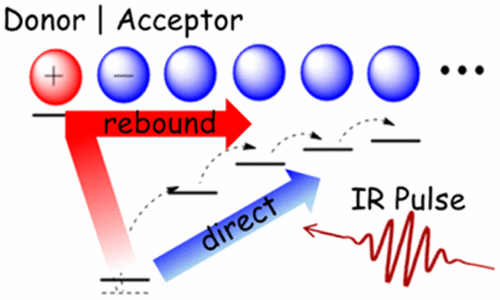当前位置:
X-MOL 学术
›
J. Phys. Chem. Lett.
›
论文详情
Our official English website, www.x-mol.net, welcomes your
feedback! (Note: you will need to create a separate account there.)
Effect of Infrared Pulse Excitation on the Bound Charge-Transfer State of Photovoltaic Interfaces
The Journal of Physical Chemistry Letters ( IF 4.8 ) Pub Date : 2017-09-25 00:00:00 , DOI: 10.1021/acs.jpclett.7b02088 Yun Geng 1, 2 , Myeong H. Lee 1, 3 , Alessandro Troisi 3
The Journal of Physical Chemistry Letters ( IF 4.8 ) Pub Date : 2017-09-25 00:00:00 , DOI: 10.1021/acs.jpclett.7b02088 Yun Geng 1, 2 , Myeong H. Lee 1, 3 , Alessandro Troisi 3
Affiliation

|
The nature and dynamics of the bound charge-transfer (CT) state in the exciton dissociation process in organic solar cells are of critical importance for the understanding of these devices. It was recently demonstrated that this state can be probed by a new experiment in which an infrared (IR) push-pulse is used to dissociate charges from the bound excited state. Here we proposed a simple quantum dynamics model to simulate the excitation of the IR pulse on the bound CT state with model parameters extracted from quantum chemical calculations. We show that the pulse dissociates the CT state following two different mechanisms: one, fairly expected, is the direct excitation of higher energy CT states leading to charge separation; the other, proposed here for the first time, is a rebound mechanism in which the negative charge is transferred in the opposite direction to form the neutral Frenkel exciton state from where it dissociates.
中文翻译:

红外脉冲激励对光伏界面束缚电荷转移状态的影响
有机太阳能电池的激子解离过程中束缚电荷转移(CT)态的性质和动力学对于理解这些器件至关重要。最近证明,可以通过一个新的实验来探究这种状态,在该实验中,使用红外(IR)推动脉冲将电荷从束缚的激发态中解离出来。在这里,我们提出了一个简单的量子动力学模型,使用从量子化学计算中提取的模型参数来模拟束缚CT态下IR脉冲的激发。我们表明,脉冲通过以下两种不同的机制使CT状态解离:一是,可以预料到的是,高能CT状态的直接激发导致电荷分离;第二,是高能CT状态的直接激发导致电荷分离。另一个是在这里首次提出的是反弹机制 其中负电荷沿相反方向转移,以形成中性的Frenkel激子态,并从中解离。
更新日期:2017-09-25
中文翻译:

红外脉冲激励对光伏界面束缚电荷转移状态的影响
有机太阳能电池的激子解离过程中束缚电荷转移(CT)态的性质和动力学对于理解这些器件至关重要。最近证明,可以通过一个新的实验来探究这种状态,在该实验中,使用红外(IR)推动脉冲将电荷从束缚的激发态中解离出来。在这里,我们提出了一个简单的量子动力学模型,使用从量子化学计算中提取的模型参数来模拟束缚CT态下IR脉冲的激发。我们表明,脉冲通过以下两种不同的机制使CT状态解离:一是,可以预料到的是,高能CT状态的直接激发导致电荷分离;第二,是高能CT状态的直接激发导致电荷分离。另一个是在这里首次提出的是反弹机制 其中负电荷沿相反方向转移,以形成中性的Frenkel激子态,并从中解离。











































 京公网安备 11010802027423号
京公网安备 11010802027423号